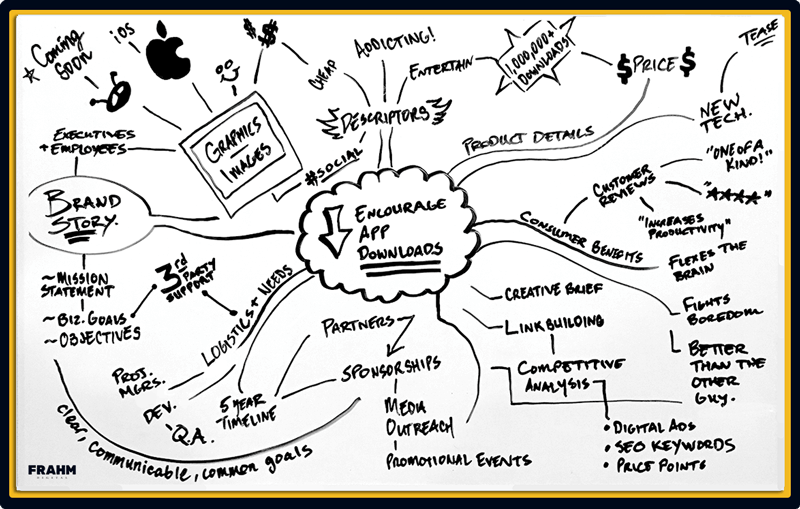
Use these links to navigate this brainstorming guide:
Why is Brainstorming Important?
Brainstorming Tips: Let's Get Started
Why is Brainstorming Important?
 With all the technical research that goes into websites -- SEO, keywords, text placement and UX -- copywriters can often be backed in a corner in terms of how they position their messaging. A solid brainstorming strategy at the beginning of a new project will help free stubborn ideas, uncover hidden messages and get the creative juices flowing. Not everything in the world of websites has to be completely data driven. In fact, that can stifle the overall effect of your copy.
With all the technical research that goes into websites -- SEO, keywords, text placement and UX -- copywriters can often be backed in a corner in terms of how they position their messaging. A solid brainstorming strategy at the beginning of a new project will help free stubborn ideas, uncover hidden messages and get the creative juices flowing. Not everything in the world of websites has to be completely data driven. In fact, that can stifle the overall effect of your copy.
Brainstorming gets you out of your comfort zone as a writer and sets up the rest of the process for success.
Set Yourself Up for Brainstorming Success
Before you develop your next big idea, here are some brainstorming tips that will help make your session a success:
- Have brain fuel on hand: Whether you order a pizza, brew up a fresh batch of coffee or even supply a sampler pack of local libations, keeping up the energy and excitement will only boost your brainstorm.
- Gather the proper resources: What do you need to help you through creative blocks? A dictionary, thesaurus and your favorite copywriting book can come in handy for quick reference.
- Set a deadline: open-ended brainstorms can be more harmful than helpful. When you set up a time limit, you create a certain sense of pressure to perform.
- Lay out brainstorm goals: You may need a fully developed slogan or just a few new product attributes. Regardless, make sure you’ve defined the goals and objectives for the brainstorm, so you can qualify your efforts.
- Gather all available info: Whether you have a simple creative brief or an entire campaign’s worth of data, make sure your entire team has access to all the available information.
Brainstorming Tips: Let's Get Started
For the purposes of this article, let’s assume you already have a creative brief in-hand with some basic campaign information. To get started, follow the tips below:
1) How to Define Personas
Before you take off on a new copywriting brainstorming exercise, make sure to define target market personas. Using demographic criteria, these fictional characters help you analyze specific personalities, needs, wants and desires, allowing you to identify what they’re looking to get from a product, service, brand or website. This gives you a better idea of what copy will speak to them, while allowing you to analyze it from their perspective.
Step 1: Name your fictional character and provide a quick summary and image
 First, give your personas unique names -- Jennifer the Lawyer, for example. Normally, unless you have an incredibly tight target market, you’ll have at least two, sometimes up to five personas, so this helps keep them straight. A one-sentence summary also helps quickly tell your team who the personas are: “Jennifer, a laser-focused, high-level criminal attorney and mother of three who responds to website copy that’s to the point, leads her step-by-step and can be visibly trusted.”
First, give your personas unique names -- Jennifer the Lawyer, for example. Normally, unless you have an incredibly tight target market, you’ll have at least two, sometimes up to five personas, so this helps keep them straight. A one-sentence summary also helps quickly tell your team who the personas are: “Jennifer, a laser-focused, high-level criminal attorney and mother of three who responds to website copy that’s to the point, leads her step-by-step and can be visibly trusted.”
Step 2: Define demographic information
This outlines the basic information of your persona -- their age, location, gender, income, family status, ethnicity and how they consume information. This information helps set up the next step. Learn more about exploring personas and target markets in our post, Content Marketing 101.
Step 3: Define psychographic information
Psychographics are more open-ended, in that you’ll need to infer a lot of the details. A good way to get more accurate psychographic information is to actually hold focus groups among your target market and have them fill out a tailored questionnaire or undergo an interview. However, as long as you have some demographic information, you can probably figure out enough psychographic information like attitudes, interests, motivations, wants, desires and weaknesses. The point of this is to understand the behavior motivating a persona in choosing your brand over another. Continuing with Jenny the Lawyer/Mom as our example, here are some useful types of psychographic information you can include:
- Jenny works long hours at the law office and dislikes wasting her free time.
- She has an in-home nanny and expects the best possible upbringing for her children.
- When they’re able to get away, her and her husband enjoy lavish trips that their income allows.
- Her standards are high in all aspects of life, and she prefers premier products and services over economy options
Step 4: Define Objectives & Goals
This is the final, motivating factor that inspires your persona to take action. What do they want or what can they accomplish from interacting with your offer? Understanding this final driving force as to what a user needs from you will help fill out the rest of the persona’s needs, desires and pain points.
Step 5: Put your persona into a scenario
Develop a scenario in which your persona ends up buying your product. What does their ideal shopping journey look like? Think of a typical day for your target audience, and create a scenario from their perspective. Jenny’s scenario, for example, could look something like this:
“Although I’m tired from working late on big legal cases, I wake up at 6:00 AM sharp, everyday, get a quick workout in, feed my children breakfast and leave for work when the nanny arrives. I spend most of the day arguing in court, representing my big-name law firm’s clients. I work strenuous 10-hour days, so I don’t have a lot of extra time to find educational toys for my children. Ideally, I’d like to find a company that delivers product recommendations right to my email or social media feed.”
2) Competitive Research
When it comes to SEO copywriting, you can’t underestimate the power of competitive research. Whether you’re writing homepage headlines, blogs, landing pages or product descriptions, you can gain great insight from doing even basic competitive research. Google your criteria and visit a few websites within the niche. Take a look at what they're doing - how are they approaching brand voice? Is it whimsical, down-to-earth, zany or professional? What types of verbs, nouns, adjectives and other descriptors are they using? What attributes do they seem to draw the most attention to? Are there any obvious uses of imagery and/or color that you could develop ideas from? Even just browsing their content can lead to a litany of ideas.
For a comprehensive competitive research strategy, take a look at these website auditing tools to help analyze key competitors.
3) Mind Mapping
Mind mapping is the practice of building a visual thought process through descriptors, attributes, benefits and drawbacks, among other things. In a stream-of-conscious fashion, mind mapping helps uncover hidden messages that may better resonate with your audience. This exercise is pretty easy, as there’s literally no right or wrong way to approach it.

Group Brainstorming Techniques
Whether you’re an agency, in-house marketing team or small business, there are a ton of ways you can improve your group brainstorming efforts – take a look at some of the ideas below to get started.

Lightning Round Robin
This brainstorming strategy is simple -- get a few creatives or copywriters in a room and do a round robin lightning session. Appoint a person as facilitator, who defines a problem needing to be solved or supplies a question about the product/service. Give the team a few minutes to think it over and then have each individual write down their ideas. Once a few minutes have gone by, have team members pass their cards to the person next to them. Before announcing them, repeat the process, growing each person’s idea. After a few rounds, gather up the cards and read them off.
You’re now in a position to discuss, eliminate and develop a wide array of ideas as you see fit. This helps give everyone on the team a chance to provide ideas, rather than just a few assertive members.
Telephone Game
If you think you have a good idea, test its memorability by doing a simple game of telephone with a group of people. If the message makes it all the way through the group and is the same at the end of the line, you may be on to a catchy idea.
Reach Out to Your Client
As long as your client won’t see it as a weakness (and it shouldn’t be considered as such) ask them for their opinions on what they’d like to see, how they expect their audience to react, and common praises and pain points of the product or service. Since they’re closer to their brand, dealing with it day-in and day-out, they can bring a micro-view to potential ideas.
Best of Luck with these Website Brainstorm Techniques
Now that you know some of the best copywriting brainstorm strategies, you can give one a try for your upcoming website project. Remember to let the ideas flow freely and always reach out to team members for extra assistance. You may well be on the verge of your next big idea -- best of luck!
Searching for more great SEO copywriting help?
Check out our blog posts below and dominate your competition with sound SEO copywriting.

